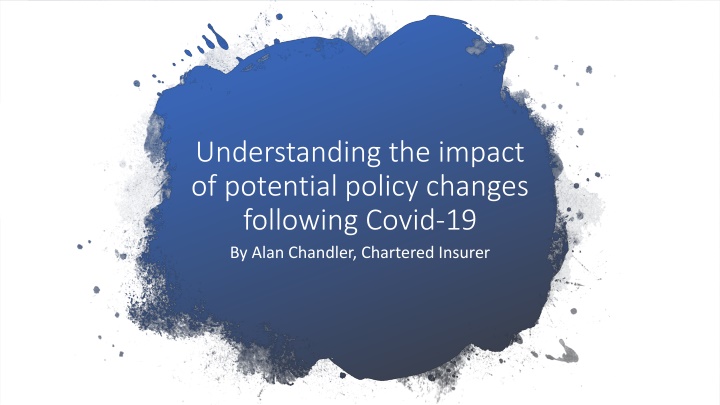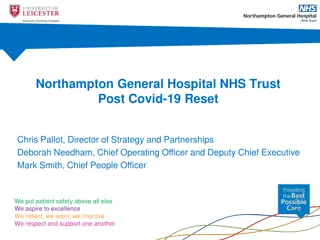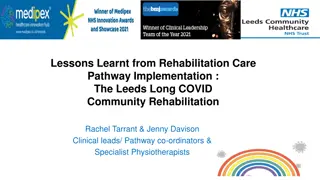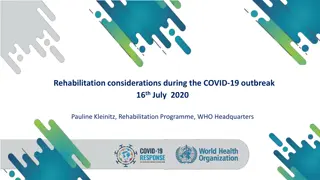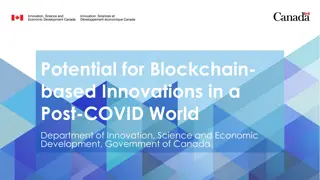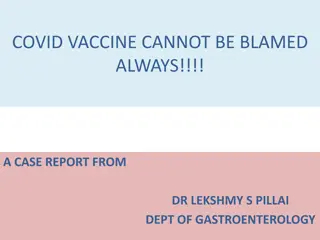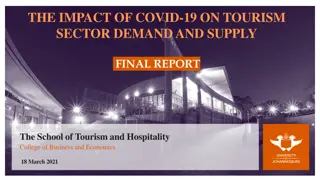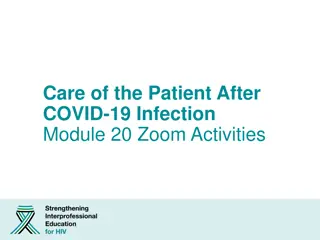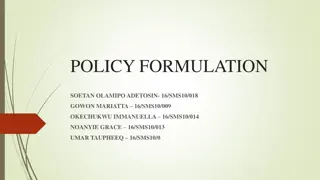Impact of Potential Policy Changes Post Covid-19
Explore the legal implications of insurance policy exclusions following Covid-19, covering Consumer Rights Act, Proximate Cause, Exclusions, and First vs. Third Party Covers. Understand where exclusions apply and their impact on claims.
Uploaded on Apr 04, 2025 | 2 Views
Download Presentation

Please find below an Image/Link to download the presentation.
The content on the website is provided AS IS for your information and personal use only. It may not be sold, licensed, or shared on other websites without obtaining consent from the author.If you encounter any issues during the download, it is possible that the publisher has removed the file from their server.
You are allowed to download the files provided on this website for personal or commercial use, subject to the condition that they are used lawfully. All files are the property of their respective owners.
The content on the website is provided AS IS for your information and personal use only. It may not be sold, licensed, or shared on other websites without obtaining consent from the author.
E N D
Presentation Transcript
Understanding the impact of potential policy changes following Covid-19 By Alan Chandler, Chartered Insurer
Alan Chandler, Chartered Insurer Alan Chandler, Chartered Insurer alanchandler@uwclub.net alanchandler@uwclub.net Linkedin Linkedin Chandler Chandler I have trained more than 2,000 individuals to become ACII qualified I have trained over 50% of the individuals in the last 8 years that have gone onto achieve the highest ACII pass in the whole of the UK. I train to a pass rate of more than 96% in all CII qualification levels. Certificate , Diploma and Advanced Diploma. I have delivered the Allianz scholarship and academy programmes in both the UK and Ireland and the Ask Alan facility for Zurich. I have delivered training throughout Europe for many major brokers and insurers. I have trained students who have won national prizes in almost all ACII subjects including Insurance Law (MO5), Liability (M96), Commercial Property and BI (M93), Personal Lines Insurance (P86), Business and Finance (M92), Underwriting Practice (M80), Advanced Underwriting (960), Claims Practice (M85), Advanced Claims (820), Marketing (945), Advanced Broking (930) and Advanced Risk Management (992).
Learning Objectives Delegates will be able to understand: How the law views insurance policy exclusions. How the Consumer Rights Act, Unfair Contract Terms Act and the EL act respond in resect of exclusions. How proximate cause applies in insurance. What is an insured peril, uninsured peril and excluded peril and what happens if more than one act together. What happens if the insurer excludes a cause whether caused directly or indirectly by a peril (sometimes known as the proximate cause or not). The legal position around the likely communicable disease exclusions on first party claims. The likely legal position around communicable disease exclusion on third party claims - including looking at the H&S at work regs 1999, H&S at work act 1974, also looking at could negligence be established on PL.
First and Third Party covers Exclusions will be applying on both first and third party covers, let s make sure we understand the difference between first and third party claims.
Exclusions simply relate to aspects of cover the insurers are not willing to provide. They cannot be breached or broken (that s the role of conditions) they simply state a set of circumstances where the insurer has no liability to pay a claim. Exclusions
Where an exclusion is placed matters Put an exclusion by a peril, it only applies to that peril. Put an exclusion in with the section exclusions it applies to that section only. Put an exclusion in the General exclusions it applies to the entire policy let s go through some examples and explore where insurers are likely to put disease exclusions.
Exclusions Exclusions The insurers broadly speaking are in a fairly strong position on exclusions compared to say conditions or warranties we will explore why. Consider the case of Blackburn Rovers FC v Avon Insurance & others (2004)
Legislation does enable challenges to contract terms, conditions and exclusions if they are unfair so maybe these can be used to challenge Covid-19 exclusions. There are two main pieces of legislation that enable the challenging of exclusions in contract law: 1. For Consumers it is the Consumer Rights Act 2015 2. For commercial customers it is the Unfair contract Terms Act 1977 So can insurers new Covid-19 exclusions be challenged under these acts?
Unfortunately they are not too much help lets understand why
EMPLOYERS LIABILITY INSURANCE IS DIFFERENT As Employers' Liability insurance is compulsory, policy exclusions are not permitted except in limited circumstances let s discuss
Proximate Cause Proximate Cause: Defined as: The active efficient cause. Which sets in motion a chain of events. Which brings about a result. Without the intervention of any force starting and working actively from a new and independent source. Why do we need to understand this with communicable disease exclusions?
Proximate Cause The leading cases. This could be important when considering Covid-19 exclusions Leyland Shipping v Norwich Union (1918) Now let s consider Etherington v. Lancashire and Yorkshire Accident Insurance Company (1906) Finally, let s consider Marsden v. City and County Insurance (1865)
We need to distinguish between: Insured Peril Proximate Cause Excluded (Excepted) Peril Uninsured Peril.
Wayne Tank and Pump Co Ltd v Employers Liability Insurance Corporation Ltd 1974 Interdependent and concurrent perils Leading cases JJ Lloyd (Instruments) Ltd v. Northern Star Insurance Co Ltd 1987
Midland Mainline Ltd. & others v Eagle Star Insurance co (2004) Hatfield rail disaster Oct 2000 caused by a rail broken as a result of fatigue cracking. Proximate Cause
So what is a remote cause ? Why could this be important if exclusions are worded in certain ways?
Remote Cause BEWARE CERTAIN EXCLUSIONS!!! A remote cause can not normally be a reason for an exclusion, but can be if the wording states this peril is excluded if it is the proximate cause OR NOT . Another way of saying this is The event is excluded whether directly OR INDIRECTLY causing the loss . These are a big worry as the exclusion does not now have to be the proximate cause do try and challenge these type of exclusions, if you can in a hard market! Let s look at case law around this
Other legal considerations when considering Covid-19 exclusions Common law rules on the meaning of words
Common law rules on the context of words the Latin special Contra Proferentem Rule
Financial Ombudsman Service (FOS) Who can refer and what is their likely response
Care about what words are used in the exclusion Insurers may exclude: 1. Covid-19 very specific 2. Pandemics wider 3. Contagious or communicable Diseases (this is a big list!) what could be the unintended consequences here? 4. What else?
EL and PL cover Heath and Safety at Work Act 1974 states that an employer must provide and maintain proper premises and equipment and provide a safe system of work. The Management of Health and Safety at Work Regulations 1999 states that an employer may be sued, if an accident at work is attributable to an employer s failure to implement a suitable and sufficient risk assessment. Your clients must provide what to be compliant?
First Party claims It is likely these will be placed in the General exclusions. Such action would negate an ability for an insured going forward to rely on a notifiable disease wording for Covid-19 coverage or a non damage denial of access under Bi. Pandemics would not normally cause property damage but issues could arise if the insurer decides to use the wording: So lets have a look at Potential Covid-19 exclusions Pandemics (or they may specifically mention Covid-19) are excluded whether directly or indirectly causing a loss. Let s explore
Third Party Claims Motor liability and EL are protected by legislation, but Public Liability Products Liability and Professional Indemnity are not. Could the insured be sued for say negligence should someone contract Covid-19 at their premises? Let s explore
What can brokers do Let s discuss
What can brokers do VERY CLEARLY and SPECIFICALLY bring to the policyholders attention the new exclusions, do not just use the phrase read your policy let s explore the main legal cases
This is not going to be easy, but remember all brokers are highly likely to remain in the same boat, bringing the same message to their clients. And finally
Learning Objectives Delegates will be able to understand: How the law views insurance policy exclusions. How the Consumer Rights Act, Unfair Contract Terms Act and the EL act respond in resect of exclusions. How proximate cause applies in insurance. What is an insured peril, uninsured peril and excluded peril and what happens if more than one act together. What happens if the insurer excludes a cause whether caused directly or indirectly by a peril (sometimes known as the proximate cause or not). The legal position around the likely communicable disease exclusions on first party claims. The likely legal position around communicable disease exclusion on third party claims - including looking at the H&S at work regs 1999, H&S at work act 1974, also looking at could negligence be established on PL.
